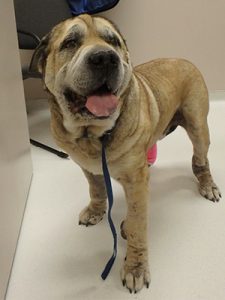What Questions Should I Ask My Vet About My Dog’s Bone Cancer Diagnosis?
 Cancer in the bones of animals has been around since the age of the dinosaurs. Today, large to giant breed dogs and older dogs tend to be diagnosed with bone cancer at a higher rate than smaller or younger dogs. Osteosarcoma accounts for 90-95% of canine bone tumors. Other bone tumors include chondrosarcoma, fibrosarcoma and hemangiosarcoma. Because bone cancer in dogs is very aggressive, it is important pursue treatment as soon as possible.
Cancer in the bones of animals has been around since the age of the dinosaurs. Today, large to giant breed dogs and older dogs tend to be diagnosed with bone cancer at a higher rate than smaller or younger dogs. Osteosarcoma accounts for 90-95% of canine bone tumors. Other bone tumors include chondrosarcoma, fibrosarcoma and hemangiosarcoma. Because bone cancer in dogs is very aggressive, it is important pursue treatment as soon as possible.
Symptoms associated with canine osteosarcoma are not always obvious. The most common bones affected are the long bones, or those of the legs. However, since any bone in the body can be affected, symptoms vary depending on the anatomic location of the cancer. For example:
- In limbs, look for limping and/or a firm swelling that doesn’t go away
- In the skull, jaw or ribs, masses or swelling can occur
- If the cancer is affecting the jaw, some dogs may have difficulty eating
- In the skull or spine, neurologic signs may be present which can include seizures and/or a wobbly gait
Any of these sites can be painful. Your dog may be lethargic, lose their normal appetite, or avoid playing due to the pain the cancer is causing.
How long can my dog live with bone cancer?
Because no two dogs are the same, it is hard to predict how long a pet will live with bone cancer without information specific to the pet and his or her cancer. Life expectancy is largely dependent on the location of the cancer, whether it has spread (metastasized), and the type of treatment chosen.
Fortunately, we have data to help us understand how the most commonly used treatment options can impact a patient’s prognosis. PetCure Oncology has treated almost 400 pets with osteosarcoma as of this post in December 2020. From published industry data, we know that dogs with bone cancer affecting a limb that receive stereotactic radiation (SRS/SRT) in combination with chemotherapy have a median survival time of about 12 months. This is about the same amount of survival time seen in dogs treated with amputation and chemotherapy. Up to 16–28% of dogs are alive at 24 months.[1] The survival time for dogs with amputation alone is generally estimated at 3-6 three months.
As advanced radiation therapy such as SRS/SRT is used more prominently, PetCure Oncology continues to collect new data on its safety and efficacy. Preliminary data suggests that dogs treated for osteosarcoma with SRS/SRT under PetCure protocols have an estimated median survival time of 537 days (or approximately 18 months).
Is canine osteosarcoma painful? Is my dog in pain?
Unfortunately, bone cancer can be very painful for dogs. Pain medications are often recommended and can be very helpful. Radiation therapy (SRS/SRT, conventional, or palliative RT) has been shown to help reduce and/or alleviate pain as well. Amputation will also alleviate the discomfort caused by cancer.
What treatment options are available if my dog has bone cancer?
The type of treatment is going to depend largely on where the cancer is located in the body, how severe the disease is, and whether or not it has spread to other parts of the body.
Some treatment options for canine osteosarcoma include:
- Stereotactic radiation (SRS/SRT) precisely targets the tumor while avoiding surgery, an appealing option when surgery is not an option or when pet owners are not comfortable with amputation. SRS/SRT is highly localized, zeroing in on the cancer cells and leaving the healthy bone cells intact. SRS/SRT allows the patient to keep their bone. Chemotherapy is typically recommended in conjunction with SRS/SRT.
- Surgical amputation to remove the affected limb. Chemotherapy is typically recommended in conjunction following amputation.
- Limb-sparing surgery, where only the bone tumor is removed and then replaced by a bone graft. Two-thirds of patients develop a localized post-op infection, sometimes necessitating a second surgery.
- Palliative treatment can be administered with either pain medication or palliative radiation. The goal is to make your dog more comfortable.
Is bone cancer in dogs curable?
It is important to speak directly with a board-certified veterinary oncologist to get a sense of your dog’s particular situation. Establishing realistic expectations for each treatment option is important in order to make the right decision for your family. As with most forms of cancer, the goal of treatment is typically to obtain a remission, extending quality of life, and preventing the spread of the disease. It is critically important to get treatment early because osteosarcoma is known to be very aggressive and spread to other parts of the body.
Do You Have More Questions About Canine Osteosarcoma?
 We are here for you. We know how scary a diagnosis of bone cancer can be. Please reach out to one of our Pet Advocates who can answer your questions. There is no charge for the call to get the answers you need.
We are here for you. We know how scary a diagnosis of bone cancer can be. Please reach out to one of our Pet Advocates who can answer your questions. There is no charge for the call to get the answers you need.
If your dog has been diagnosed with bone cancer – don’t lose hope. Treatment options are available. Be sure to contact your veterinarian as soon as possible. Call PetCure Oncology today to get answers about your dog’s bone cancer diagnosis at 833-738-4376.
Pet Hero Story
Meet Rufus, 100 pounds of lovable Mastiff and an osteosarcoma survivor! Read about Rufus’s treatment journey.
